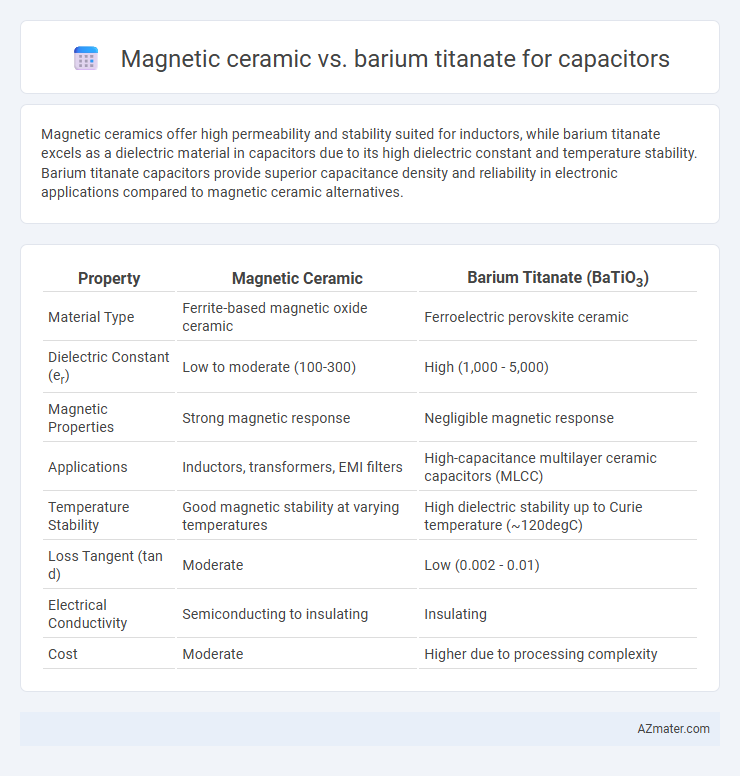Magnetic ceramics offer high permeability and stability suited for inductors, while barium titanate excels as a dielectric material in capacitors due to its high dielectric constant and temperature stability. Barium titanate capacitors provide superior capacitance density and reliability in electronic applications compared to magnetic ceramic alternatives.
Table of Comparison
| Property | Magnetic Ceramic | Barium Titanate (BaTiO3) |
|---|---|---|
| Material Type | Ferrite-based magnetic oxide ceramic | Ferroelectric perovskite ceramic |
| Dielectric Constant (er) | Low to moderate (100-300) | High (1,000 - 5,000) |
| Magnetic Properties | Strong magnetic response | Negligible magnetic response |
| Applications | Inductors, transformers, EMI filters | High-capacitance multilayer ceramic capacitors (MLCC) |
| Temperature Stability | Good magnetic stability at varying temperatures | High dielectric stability up to Curie temperature (~120degC) |
| Loss Tangent (tan d) | Moderate | Low (0.002 - 0.01) |
| Electrical Conductivity | Semiconducting to insulating | Insulating |
| Cost | Moderate | Higher due to processing complexity |
Introduction to Capacitor Dielectrics
Magnetic ceramics and barium titanate serve distinct roles in capacitor dielectrics, with magnetic ceramics primarily used for inductive components due to their high permeability, whereas barium titanate excels as a dielectric material because of its high dielectric constant and ferroelectric properties. Barium titanate's perovskite structure enables significant polarization under an electric field, leading to increased capacitance and improved energy storage capabilities in ceramic capacitors. Capacitors utilizing barium titanate dielectrics offer enhanced performance in applications requiring stable dielectric properties and temperature resilience compared to magnetic ceramic counterparts.
Overview of Magnetic Ceramics
Magnetic ceramics, also known as ferrites, are composed primarily of iron oxide combined with other metal oxides, offering high magnetic permeability and low electrical conductivity, which minimize eddy current losses in capacitors. These materials are valued for their stability at high frequencies and excellent magnetic properties, making them suitable for inductors and magnetic cores within capacitor structures. Compared to barium titanate, magnetic ceramics generally exhibit lower dielectric constants but provide superior magnetic performance, enhancing energy storage and filtering capabilities in specialized capacitor applications.
Barium Titanate: Properties and Uses
Barium titanate exhibits high dielectric constant, excellent ferroelectric properties, and stable temperature performance, making it ideal for multilayer ceramic capacitors (MLCCs) in electronic circuits. Its perovskite crystal structure enables effective polarization under electric fields, enhancing capacitance and energy storage. Common applications include capacitors in telecommunications, automotive electronics, and nonlinear optical devices due to its reliability and efficiency.
Dielectric Performance Comparison
Magnetic ceramics typically exhibit lower dielectric constant values compared to barium titanate, which is renowned for its high permittivity, often exceeding 1000, making it ideal for high-capacitance capacitor applications. Barium titanate's superior dielectric strength and low loss tangent contribute to enhanced energy storage efficiency and stability under varying frequencies and temperatures. In contrast, magnetic ceramics generally offer better magnetic properties but fall short in dielectric performance, limiting their effectiveness in high-performance capacitors.
Capacitance Stability under Temperature Variations
Magnetic ceramics exhibit superior capacitance stability under temperature variations compared to barium titanate, which tends to experience significant dielectric constant fluctuations due to its ferroelectric nature. Barium titanate capacitors often show a marked decrease in capacitance at elevated temperatures and near the Curie point, leading to reduced performance in high-temperature applications. Magnetic ceramic capacitors maintain consistent dielectric properties across a broader temperature range, making them more reliable for environments with variable thermal conditions.
Frequency Response Analysis
Magnetic ceramics exhibit a stable frequency response with low dielectric loss, making them suitable for high-frequency capacitor applications, while barium titanate displays a high dielectric constant but suffers from significant frequency-dependent permittivity variations. Frequency response analysis reveals that barium titanate capacitors show marked reduction in capacitance and increased dielectric loss at higher frequencies, limiting their efficiency in RF circuits. Magnetic ceramic capacitors maintain consistent performance across a broad frequency spectrum, providing enhanced reliability for high-frequency electronic devices.
Manufacturing Process Differences
Magnetic ceramics typically involve a sintering process at higher temperatures with controlled atmosphere conditions to achieve specific magnetic properties, whereas barium titanate capacitors are manufactured through a solid-state reaction or sol-gel process followed by precise calcination to optimize dielectric characteristics. Magnetic ceramics often require complex compositional adjustments and dopants during milling to control grain size and magnetic permeability, while barium titanate manufacturing emphasizes phase purity and grain boundary engineering for enhanced dielectric constant and temperature stability. The pressing and firing stages in magnetic ceramics focus on achieving ferrite structures, contrasted with barium titanate ceramics, where careful thermal treatment ensures ferroelectric domain alignment critical to capacitor performance.
Cost and Availability
Magnetic ceramic capacitors typically offer moderate cost and widespread availability due to their common use in various electronic applications. Barium titanate capacitors tend to be more expensive because of the higher purity materials and complex manufacturing processes involved. Availability of barium titanate capacitors can be limited compared to magnetic ceramics, especially in bulk quantities for industrial use.
Applications in Modern Electronics
Magnetic ceramics and barium titanate serve distinct roles in modern electronics capacitors, where magnetic ceramics are preferred for high-frequency inductive components and energy storage due to their excellent magnetic permeability and thermal stability. Barium titanate, a ferroelectric material, excels in multilayer ceramic capacitors (MLCCs) with high dielectric constants, enabling miniaturization and high capacitance in portable devices such as smartphones and laptops. The synergy between magnetic ceramics and barium titanate materials drives advancements in RF circuits, power electronics, and embedded capacitors for next-generation electronic systems.
Future Trends and Innovations
Magnetic ceramic materials are gaining traction due to their enhanced dielectric properties and superior energy storage capabilities compared to traditional Barium titanate, which remains prominent for its high permittivity and temperature stability in capacitors. Future trends emphasize the integration of nanostructured magnetic ceramics to improve frequency response and reduce power losses, targeting advanced electronics and electric vehicle applications. Innovations focus on hybrid composites combining Barium titanate and magnetic ceramics to achieve tunable dielectric constants and improved miniaturization in next-generation capacitor technologies.

Infographic: Magnetic ceramic vs Barium titanate for Capacitor
 azmater.com
azmater.com